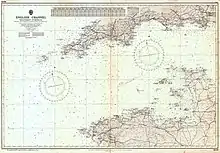Hurd's Deep
Hurd's Deep (or Hurd Deep) is an underwater valley in the English Channel, northwest of the Channel Islands. Its maximum depth is about 180 m (590 ft; 98 fathoms), making it the deepest point in the English Channel.


Etymology
It is most probable the feature was named after Captain Thomas Hurd RN (1747–1823), by Admiral Martin White.[1]
Description
The feature has approximate dimensions of length of 150 km (93 mi); width of between 2 km (1.2 mi) and 5 km (3.1 mi) and maximum depth of 170 m (560 ft; 93 fathoms). It terminates abruptly at the western end. Outside of the deep the seafloor is typically flat with a depth range of 70 m (230 ft; 38 fathoms) to 90 m (300 ft; 49 fathoms).[2] It is the deepest point on the English channel.[3]
Late Quaternary origin
The underwater valley system found on the floor of the eastern English Channel formed from a catastrophic flood which was caused by a breaching of a rock dam at the Strait of Dover, which released a huge proglacial lake in the southern North Sea basin. The flood scoured the former river systems to form Hurd's Deep in late Quaternary times.[4][5]
Pleistocene glacial refugium
During the ice ages, when the sea level dropped, most of the English Channel was dry land. Hurd's Deep likely remained as a sea. During the Pleistocene it is thought to have been a glacial refugium.[6]
Seabed
Dumping
Following the First World War, Hurd's Deep was used by the British Government as a dumping ground for both chemical and conventional munitions.[7] SMS Baden was scuttled there in 1921.[8] Following the Second World War, it was used to dump military equipment, munitions and weaponry left behind by the ousted German invaders of the Channel Islands.[9] Routine dumping of British munitions carried on until 1974.[7][10][lower-alpha 1]
Between 1946 and 1973 the area was also used for the dumping of low and intermediate level radioactive wastes. 28,500 barrels of waste – including plutonium, which has a half-life of 24,100 years – were disposed of into the Deep during this period.[11][12]
Shipwrecks
The British submarine HMS Affray sank in Hurd's Deep in 1951 with the loss of 75 lives.[13]
In popular culture
In Harry Collingwood's science fiction stories about the Flying-Fish airship-submarine, the Flying-Fish is hidden in Hurd's Deep between adventures.[lower-alpha 2]
Notes, references and sources
Notes
- Admiralty Chart No 2649 English Channel Western Portion of 1955 shows munitions have been dumped there but cannot confirm further details
- The three stories are:
- The Log of the ‘Flying Fish’: A Story of Aerial and Submarine Peril and Adventure (1887)
- With Airship and Submarine: A Tale of Adventure (1907)
- The Cruise of the 'Flying-Fish': The Airship-Submarine (1924)
References
- Davies, Martin (1973). "Martin White RN". La Société Jersiaise. The Island Wiki. Archived from the original on 27 February 2019. Retrieved 3 March 2019.
- Lericolais, G.; Guennoc, P.; Auffret, J. P.; Bourillet, J. F.; Berne, S. (7 October 1996). "Detailed survey of the western end of the Hurd Deep (English Channel): new facts for a tectonic origin". In De Batist, M.; Jacobs, P. (eds.). Geology of Siliciclastic Shelf Seas. Geological Society. ISBN 978-1897799710.
- Oggioni (2013), p. 42.
- Smith, Alec J. (1985). "A catastrophic origin for the palaeovalley system of the eastern English Channel". Marine Geology. 64 (1–2): 65–75. Bibcode:1985MGeol..64...65S. doi:10.1016/0025-3227(85)90160-4.
- Gupta, Sanjeev; Collier, Jenny S.; Palmer-Felgate, Andy; Potter, Graeme (2007). "Catastrophic flooding origin of shelf valley systems in the English Channel". Nature. 448 (7151): 342–345. Bibcode:2007Natur.448..342G. doi:10.1038/nature06018. PMID 17637667.
- Provan, Jim; Bennett, K.D. (2008). "Phylogeographic insights into cryptic glacial refugia". Trends in Ecology and Evolution. 23 (10): 564–571. doi:10.1016/j.tree.2008.06.010. PMID 18722689.
- Replacement Metallic Return Conductors - Marine Environmental Report (PDF) (Report). 4. Moyle Interconnector Ltd. December 2014. pp. D3–D4. Archived (PDF) from the original on 16 August 2019. Retrieved 16 August 2019.
- Schleihauf, p. 81.
- Carr, Gilly (7 March 2014). Legacies of Occupation: Heritage, Memory and Archaeology in the Channel Islands. p. 30. ISBN 978-3319034065.
- "Alderney Hurd Deep radioactive waste 'not dangerous'". BBC. 18 April 2013. Archived from the original on 13 February 2016. Retrieved 15 August 2019.
- Nuclear dumping leak sparks concern Archived 11 March 2006 at the Wayback Machine – BBC, 17 January 2002
- "Thousands of radioactive waste barrels rusting". Greenpeace. 19 June 2000. Archived from the original on 28 June 2009.
- "1951: Fears for crew of lost British submarine". Archived from the original on 7 March 2008. Retrieved 31 December 2007.
Sources
- Oggioni, Francesa (2013). Characterization of catastrophic flood-related features in the English Channel (PDF) (Phd). London: Imperial College. Archived (PDF) from the original on 18 June 2020.
- Schleihauf, William (2007). "The Baden Trials". In Preston, Anthony (ed.). Warship 2007. Annapolis: Naval Institute Press. ISBN 978-1-84486-041-8.
